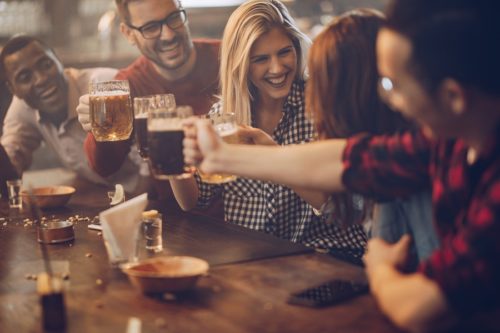Read the latest and greatest from our team
of incredible specialists.

Beach House Recovery Center » Blog » Social Drinker vs. Alcoholic: Understanding the Differences
Alcohol is a common substance that many people around the world consume. However, there is a big difference between someone who enjoys a drink occasionally and someone who struggles with alcoholism.
This blog post will discuss the differences between social drinkers, problem drinkers, and alcoholics, as well as the warning signs of alcoholism. Continue reading to learn more.

To understand the difference between social drinking and problematic alcohol use, it’s helpful to know what constitutes a “standard drink.” This is defined as containing 14 grams of pure alcohol, equivalent to:
It’s important to note that bartenders often pour more than 1.5 ounces of liquor into mixed drinks or shots, and beer is commonly served in 16-ounce pint glasses.
A social drinker is someone who consumes alcohol primarily in social settings. They typically drink in moderation and do not experience negative consequences from their alcohol consumption.
Key characteristics of a social drinker include:
It’s important to note that the line between social drinking and problematic drinking can be blurry. If you or someone you know is concerned about their alcohol consumption, it’s essential to seek professional help.
A problem drinker is someone whose alcohol consumption has started to negatively impact their life. This is a broader term than alcoholism and encompasses a range of drinking behaviors that cause issues.
Signs of problem drinking include:
Alcoholism, also known as Alcohol Use Disorder (AUD), is a chronic and relapsing disease characterized by an impaired ability to stop or control alcohol use despite negative consequences.
Key characteristics of alcoholism include:
It’s important to note that alcoholism is a complex condition influenced by genetic, environmental, and psychological factors.
If you are wondering whether you or someone in your life might be an alcoholic, here are some warning signs to look for. Though this list is not all-inclusive, it does represent many of the common traits alcoholics share.
If you recognize these signs of Alcohol Use Disorder, know that recovery is possible. Honesty about your relationship with alcohol is crucial. Professional help at Beach House can guide you toward healing.
AUD is a treatable condition, and with the right support, you can reclaim your life. Isolation is common but unnecessary. Connect with us today to explore evidence-based treatment options for lasting sobriety.
Whether you’re researching for yourself or a loved one, Beach House can help. We understand that this is a serious time in your life and that the treatment center you choose matters. We want you to feel comfortable and empowered to make the right decision for yourself, a friend, or a family member. This is why a counselor is waiting and available to answer your questions and help put your mind at ease regarding the next steps. Many of the staff at Beach House have walked in your shoes. If you feel you’re ready or want more information about how to help a loved one, we can help today. You can also learn why we are voted the #1 rehab for addiction treatment in Florida.
We accept most major insurance plans and can verify your benefits quickly and confidentially.
We’re committed to helping you access the care you need, our admissions counselors can guide you through your coverage options and available resources.





"*" indicates required fields